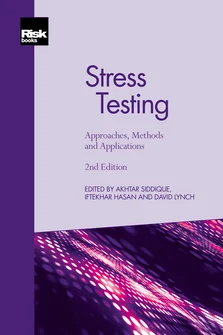Stress Testing for Market Risk
Dilip K Patro, Akhtar Siddique and Xian Sun
Stress Testing for Market Risk
Foreword
Introduction
Response to Financial Crises: The Development of Stress Testing over Time
Stress Testing and Other Risk Management Tools
Econometric Pitfalls in Stress Testing
Stress-testing applications of Machine Learning Models
Four Years of Concurrent Stress Testing at the Bank of England: Developing the Macroprudential Perspective
Stress Testing for Market Risk
The Evolution of Stress Testing Counterparty Exposures
Liquidity Risk: The Case of the Brazilian Banking System
Operational Risk: An Overview of Stress-testing Methodologies
Peacetime Stress Testing: A Proposal
Stress-test Modelling for Loan Losses and Reserves
A New Framework for Stress Testing Banks’ Corporate Credit Portfolio
EU-wide Stress Test: The Experience of the EBA
Stress Testing Across International Exposures and Activities
The Asset Market Effects of Bank Stress-test Disclosures
An Alternative Approach to Stress Testing a Bank’s Trading Book
Determining the Severity of Macroeconomic Stress Scenarios
Governance over Stress Testing
Stress testing has received increased attention from both financial institutions and regulators since the 2007–09 financial crisis. What constitutes reliable and relevant stress tests, however, still stirs a lot of debate among practitioners, stakeholders and researchers. The development and evolving practices of stress testing in the area of market risk management are reviewed in this chapter. In addition, the ways in which stress-testing methodology can be improved for risk management is presented.
Generally speaking, market risk refers to changes in a financial institution’s portfolio values due to unanticipated changes in market risk factors, such as the prices and volatilities of equities, interest rates and credit spreads, and the prices of commodities and foreign exchange rates. Stress testing for market risk has been an important component of stress tests, both in the internal stress tests run by banking organisations and in those run by financial regulators. During the financial crisis, the largest losses were often in portfolios sensitive to market risk. Traditionally, stress tests for market risk have been conducted for portfolios in banks’ trading books by using
Copyright Infopro Digital Limited. All rights reserved.
As outlined in our terms and conditions, https://www.infopro-digital.com/terms-and-conditions/subscriptions/ (point 2.4), printing is limited to a single copy.
If you would like to purchase additional rights please email info@risk.net
Copyright Infopro Digital Limited. All rights reserved.
You may share this content using our article tools. As outlined in our terms and conditions, https://www.infopro-digital.com/terms-and-conditions/subscriptions/ (clause 2.4), an Authorised User may only make one copy of the materials for their own personal use. You must also comply with the restrictions in clause 2.5.
If you would like to purchase additional rights please email info@risk.net











